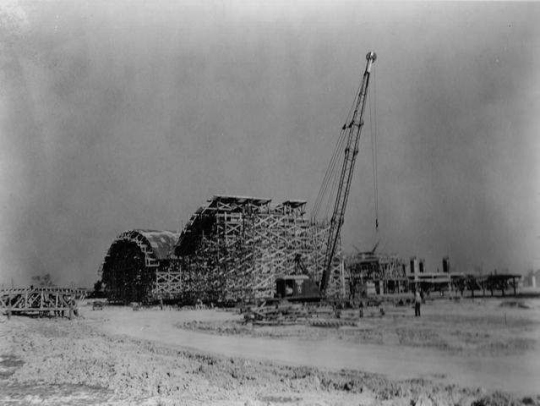 A hangar under construction at NAS Patuxent River in 1942. (U.S. Navy photo)
A hangar under construction at NAS Patuxent River in 1942. (U.S. Navy photo)PATUXENT RIVER, Md. (April 1, 2016)—The expansion of the armed forces during World War II brought major changes to naval aviation's infrastructure. The test and evaluation facilities at NAS Anacostia quickly became inadequate due to the growing complexity, size and number of aircraft, in addition to the area's swelling population. A new location in the general area of Washington, D.C., became essential but it also had to be sufficiently isolated and allow for exhaustive aircraft testing and evaluation.
When the 6,400-acre site at Cedar Point, Maryland was acquired, it included well-developed prime farmland consisting of several large farms—Mattapany, Susquehanna and Cedar Point—as well as numerous tenant and sharecropper properties and a few clusters of vacation homes along the Chesapeake Bay. The Cedar Point community included several churches, a cemetery, a post office and a gas station.
Construction began April 4, 1942, and an initial workforce of 650 laborers rapidly grew to 7,000 within nine months, as workers descended upon Southern Maryland to fill the high-paying construction jobs on station.
To house and feed so many workers, 33 barrack-type buildings with tarpaper roofs were erected and a large cafeteria was constructed that could feed 600 workers at one sitting.
Vast areas of ground were being built with runways and taxiways, utilities and hundreds of buildings. Old roads were rerouted and new roads installed. Southern Maryland Electric was not able to generate enough electrical power to meet the needs of the activities, so a diesel-powered electrical plant had to be built to augment the electrical supply. That power plant—Building 516 on Millstone Road—is now used for office space.
Construction was fast and furious and only one year later, NAS Patuxent River was commissioned on April 1, 1943.
During the commissioning ceremony, Rear Adm. John McCain, then-chief of the Navy's Bureau of Aeronautics, said, "Our service has commissioned many naval air stations, but never one with possibilities of such far reaching importance as Naval Air Station Patuxent River."
1940s
• By Pax River's commissioning in 1943, the Flight Test, Radio Test, Aircraft Armament and the Aircraft Experimental and Development Squadrons are in place
• The first U.S. all jet-powered airplane, the XP-59A is flight tested in 1944
• Naval Air Test Center is established as a separate entity June 16, 1945, which organizationally divided the test and support functions
• The FR-1 Fireball and the FH-1 Phantom are tested here
• Test Pilot Training Division is established in 1946, formalizing classroom instruction to evaluate aircraft and equipment for combat capabilities
1950s
• Faced with developed jet aircraft and improving existing conventional weapons during the Korean War in 1950-1953, efforts intensified at Pax River
• Several airborne early warning squadrons operated from the installation in the 1950s, patrolling the Atlantic Ocean along the Distant Early Warning Line
• In 1953, the Tactical Test Division and the Service Test Division merge
1960s
• Hostilities in Southeast Asia bring a sense of urgency to test programs here, particularly those dealing with ordnance
• A buildup of fleet anti-submarine warfare squadrons is taking place. Patrol Squadrons 8, 24, 44, 49 and 56 form Fleet Air Wing Patuxent, which later becomes Fleet Air Wing Five.
• Oceanographic Development Squadron Eight, then known as the Oceanographic Air Survey Unit, is homeported here in 1965
• Fleet Air Reconnaissance Squadron Four is established in 1968
• Three divisions of the test center—Flight Test, Service Test and Weapons Systems Test—give up assets to enable the Technical Support Division to form in 1967
1970s
• Air Test and Evaluation Squadron One moves from Key West, Florida, to Pax River in 1973
• Reorganization in 1975 prepares NATC for its role as the Naval Air Systems Command's principal site for developmental testing
• F/A-18 Hornets arrive for evaluation trials
• Computers are having a profound effect on airplanes and their systems, and testing by simulation as well as by flight is becoming an economic necessity
• Major upgrading of testing facilities begins in the late 1970s with some of the largest construction appropriations in the history of the station.
1980s
• Production prototype of P-3C Orion Update III lands at Pax for testing
• First prototype model of S-3B Viking arrives
• Production model of E-6A arrives for electromagnetic testing
• Construction of Aircraft Anechoic Test Facility begins
1990s
• Naval Air Warfare Center Aircraft Division (NAWCAD) is established January 1, 1992
• First flight of X31A
• First Bell Boeing V-22 arrives for flight-test phase
• Naval Air Systems Command (NAVAIR) Headquarters stands up at Pax River in 1997
2000s
• X-35C Joint Strike Fighter concept demonstrator arrives
• EA-18G Growler developmental test aircraft arrives 2006
• Broad Area Maritime Surveillance-Demonstrator (BAMS-D) arrives
• First flight of the X-47B Unmanned Combat Air System demonstrator July 29, 2012


